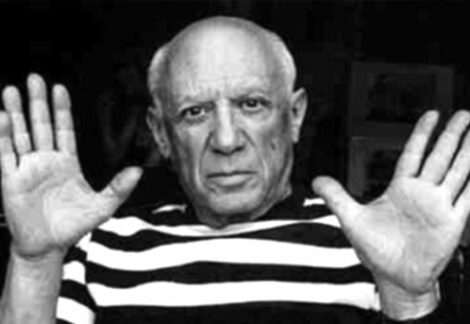With Theatre Picasso now showing at Tate Modern, we’ve been thinking about how the artist’s influence extends far beyond the canvas — into how he looked, moved and dressed. Clothes can be a kind of canvas, too. For many artists, a distinctive “uniform” isn’t just about practicality in the studio; it’s part of their identity, an extension of their practice and sometimes as recognisable as their work.
These artists show how wardrobe choices can become iconic signatures. To celebrate, we’ve paired each of them with a piece from our Readywear range – proof that a uniform can be both functional and expressive.
Pablo Picasso: Stripes, scarves and myth-making
Few artists understood the power of an image like Pablo Picasso. His striped Breton shirt – once a French naval uniform – became his visual emblem, immortalised in countless photographs. But it wasn’t the only accessory that defined him. In several portraits, Picasso appears with a polka-dot scarf knotted at his neck, adding a note of flamboyance to his otherwise simple, utilitarian look.
The scarf captures what Picasso did best: taking something ordinary and turning it into myth. A practical accessory became part of the legend, softening the rugged lines of his workwear while marking him out as a man who cared about image as much as art. The look cemented him as the archetypal bohemian – equal parts craftsman, provocateur and style icon. The Musée Picasso in Paris has also recently re-examined his wardrobe and persona in exhibitions that remind us how central self-presentation was to his legacy.
Pair it with: our Readywear neckerchief. A small detail that makes a big impact, it’s the kind of finishing touch Picasso understood instinctively – wearable art that signals individuality without saying a word.
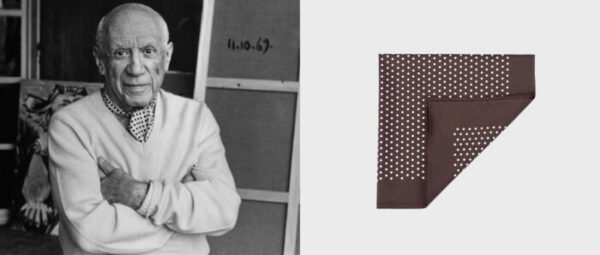
Lee Bul: where art meets armour
South-Korean artist Lee Bul is celebrated for her futuristic sculptures and installations, often evoking cyborgs, armour and mirrored architectures. When the Hayward Gallery staged her landmark exhibition in 2018, Field Grey was invited to create a bespoke apron for the exhibition shop — a retail piece that reflected her sculptural sensibility while remaining wearable and functional.
For us, it was a defining moment in our work in the retail sector. The Hayward’s shop is an extension of the exhibition itself – a space where visitors continue to engage with the artist’s world through carefully considered design. The apron was more than merchandise; it became a continuation of the show’s language, translating Lee Bul’s futuristic forms into fabric.
Her “uniform” is both practical and performative. The monochrome palette allows her personality and work to shine, while the sculptural quality of her clothing aligns her with the subjects she creates. Much like her crystalline towers and mirrored forms, her dress communicates strength, futurism and a refusal to be constrained by traditional expectations of how a woman artist “should” appear.
That link between dress and vision will be explored again in Lee Bul: From 1998 to Now, opening at Seoul’s Leeum Museum of Art in September 2025 – a survey that promises to cement her place as one of the defining sculptors of her generation.
Pair it with: our Readywear apron. Simple, hardworking, and sculptural in its own right, it’s a garment that bridges practicality and performance – just as Lee Bul does.
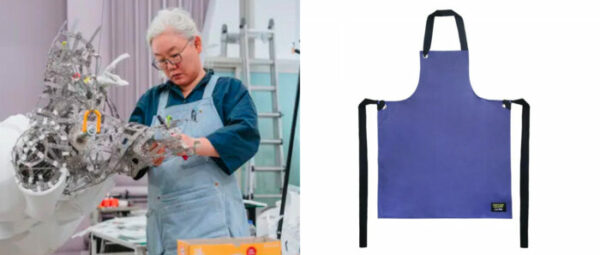
David Hockney: dressing in full colour
David Hockney’s clothes are as much a signature as his brushstrokes. Over decades, he cultivated a personal “uniform” – the blue Oxford shirt, yellow tie, grey cardigan, pleated trousers, round spectacles and newsboy cap. But one detail really stood out: his socks. Bold stripes, pastel shades, mismatched colours – Hockney’s ankles were always alive with painterly joy.
That flash of colour was more than eccentricity. It was an extension of his eye for contrast and play, the same instinct that makes his portraits and landscapes sing. Just as he layered textures on canvas, he layered surprise into everyday dressing. The Fondation Louis Vuitton’s recent blockbuster Hockney 25 (April–August 2025) underlined this joyful eye for colour, bringing together 400 works and reminding us how his personal style has always run in parallel with his art.
Pair it with: our Peper Harrow socks. Bright, colourful, and designed to be noticed – a small but joyful statement, just like Hockney’s.
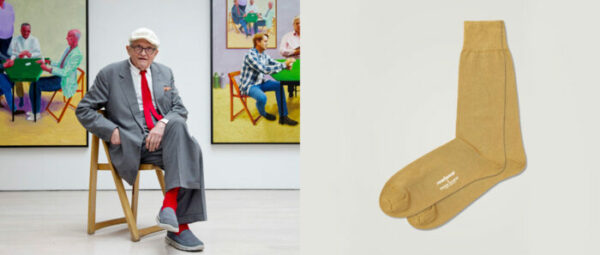
Barbara Hepworth: Sculpting an image of strength
Barbara Hepworth’s chiselled forms helped define modern sculpture in Britain. Her style of dress was just as assured. In photographs, she appears in practical trousers, simple jumpers and work jackets, often dusted with plaster or stone. The uniform was both necessity and statement: functional clothing for a woman working with chisels, saws and heavy blocks of material at a time when few expected women to be sculptors.
Her look projected authority. Hepworth was not dressing for fashion but for labour, for the reality of her practice. Yet that simplicity carried aesthetic weight. The plain cuts and muted tones harmonised with her sculptures – organic forms smoothed by hand, shapes pared down to their essentials. That modernist clarity has been highlighted recently at the Hepworth Wakefield, where her work continues to anchor the collection and inspire new audiences. Decades later, her wardrobe still resonates: designer Roksanda Ilinčić even drew directly on Hepworth’s studio style for her SS26 collection.
Pair it with: our Chore Jacket. Functional, timeless, and designed for movement – the kind of garment Hepworth might have reached for before heading into the studio.

Austyn Weiner: The next generation of studio style
If Picasso’s stripes became legendary, Austyn Weiner’s paint-splattered track pants may be on their way to cult status. The Miami-born, LA-based painter (b. 1989) has spoken about her studio “uniform”: wearing the same plain trousers every day, so the fabric becomes a living map of her labour. The marks of paint and time aren’t accidents – they’re part of the work.
Her uniform is pragmatic, but also performative. It creates a safe space, a boundary within which she can experiment freely. In collaboration with Each x Other, she framed clothing as identity and comfort: a way to “feel safe inside of who you really are.” That ethos shaped her recent debut solo show Half Way Home at Lévy Gorvy Dayan in New York (May–July 2025), where the energy of her studio practice was written into the paintings themselves.
Pair it with: our Elasticated Trouser. Understated, versatile, and made to move with you, they’re a contemporary echo of Weiner’s studio essential – trousers that evolve with every day’s work.
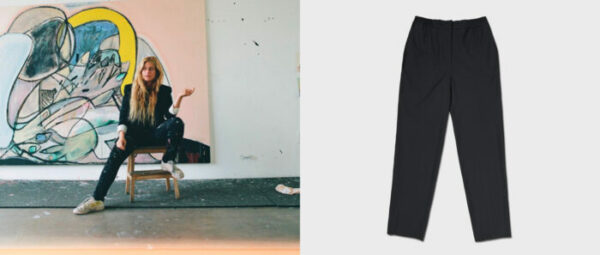
From Hepworth’s plaster-dusted jackets to Hockney’s jubilant socks, from Lee Bul’s sculptural black to Austyn Weiner’s evolving trousers, these artists prove that uniforms can be practical, symbolic, or simply joyful. Each has shaped a look that’s become inseparable from their art. With Readywear, we celebrate that spirit – functional garments with character, designed to work as hard as you do.

